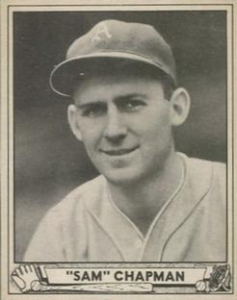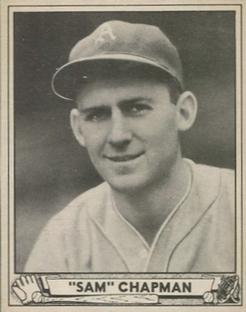May 5, 1939: Athletics’ Sam Chapman snaps 1-for-16 start to season by hitting for the cycle
 Twelve games into the 1939 season found both the Philadelphia Athletics and St. Louis Browns at or near the bottom of the American League standings. The Athletics had managed only three wins, with only one victory in their last eight games. They had scored just 18 runs in that span.
Twelve games into the 1939 season found both the Philadelphia Athletics and St. Louis Browns at or near the bottom of the American League standings. The Athletics had managed only three wins, with only one victory in their last eight games. They had scored just 18 runs in that span.
The Browns did not have trouble scoring runs, but they did have problems preventing their opponents from scoring. After winning four times in a seven-game road trip to start the season, the Browns began a lengthy homestand, welcoming six visiting teams in 16 days. In its first five games at Sportsman’s Park, St. Louis had scored 39 runs on 60 hits against the Chicago White Sox, Washington Senators, and Athletics, but had only one victory to show.
A gathering of 1,238 fans paid to see the second game of a three-game series between the Athletics and Browns on May 5.1 This marked the fourth consecutive home game in which the Browns drew fewer than 1,500 spectators.2
Right-hander Bill Trotter started for the home team. After a 2-9 rookie season in St. Louis in 1937, he spent most of 1938 in the minors with the Texas League’s San Antonio Missions, winning 22 games and posting a 2.28 ERA. He had one appearance for the Browns, a complete-game loss at the end of the season. Back with St. Louis in 1939 at age 30, Trotter split time as a starter and reliever. This game was his first start of the season.
Nels “Clint” Potter had the mound duties for Philadelphia. The 27-year-old righty was also in his second full season in the majors, and after an unimpressive rookie campaign (2-12 record, 6.47 ERA), Potter was making his second start of the year.
The Browns broke onto the scoreboard first. In the bottom of the opening frame, Mel Mazzera reached on a one-out walk. Mazzera was red-hot, banging out 17 hits in his previous six games, a .586 average, and ripping two homers in St. Louis’s 9-3 win in the series opener. He moved to second on a passed ball and scored on George McQuinn’s single.
McQuinn was caught trying to steal second and Myril Hoag – who had joined the Browns in an offseason trade after seven seasons and three World Series championships with the New York Yankees – fouled out to catcher Frankie Hayes, but St. Louis had grabbed a 1-0 lead.
With one out in the top of the second inning, Philadelphia center fielder Sam Chapman stepped into the batter’s box. An All-American football player at the University of California and the Washington Redskins’ third-round selection in the 1938 National Football League draft, Chapman chose baseball after Ty Cobb recommended him to Athletics manager Connie Mack; he hit .259 with 41 extra-base hits as a rookie in 1938.
Chapman was off to a slow start with just one hit – an Opening Day single – in his first 16 at-bats of 1939, but he drove Trotter’s pitch to the center-field wall, at the flagpole 425 feet from home plate, for a triple.
Trotter, however, stranded Chapman at third, as Dario Lodigiani hit a pop fly that shortstop Red Kress caught in shallow left field, and Skeeter Newsome grounded out to third baseman Harlond Clift.
An inning later, the Macks turned the game in their favor, sending 10 batters to the plate and chasing Trotter. Potter himself started the third-inning rally with a double to left. After second baseman Don Heffner dropped Dee Miles’s foul ball for an error, Miles singled to center, plating Potter. Joe Gantenbein also singled, and then Bob Johnson cleared the bases by “crashing a pitch high up into the left-field seats”3 for his first homer of the season and a 4-1 Philadelphia lead.
Hayes singled to left, and Harry Kimberlin was called in from the bullpen to relieve Trotter. There were still none out. Nick Etten hit a grounder to first baseman McQuinn, who muffed it and everyone was safe. Chapman followed with a double to left, and Hayes scored the fifth run of the inning.
The Browns put runners on the corners with two outs in their turn in the third, but Potter escaped without allowing a run. In the fifth, Chapman hit the ball into the left-field bleachers. It was the 23-year-old’s first round-tripper of the season and third extra-base hit in three at-bats,4 and it gave the A’s a five-run cushion.
St. Louis made it closer in the home half of the fifth. Joe Glenn led off by crushing a Potter pitch, sending it well beyond the left-field barrier. An out later, Tommy Thompson singled and then moved to second on a wild pitch. After Potter struck out Mazzera, McQuinn’s triple to left brought Thompson home, making it 6-3.
Kimberlin kept the Browns in the game with a scoreless sixth but ran into trouble in the seventh inning. Johnson and Hayes hit back-to-back singles to start the inning. Etten brought them both home with his first triple of the season.
After Chapman grounded out, with Etten holding at third, Kimberlin threw a fastball that sailed into Lodigiani. The ball struck the 22-year-old third baseman under the left temple, and he “fell as if pole-axed and had to be carried to the clubhouse on a stretcher.”5 According to the Philadelphia Inquirer, Lodigiani was unconscious for about 15 minutes.6
Bill Nagel replaced Lodigiani,7 and Newsome grounded a comebacker to Kimberlin, who fired home in time to get Etten at the plate. Potter’s lineout ended the inning with Philadelphia ahead 8-3.
Right-hander Fred Johnson took over on the mound for St. Louis in the eighth. He had pitched in five games for the New York Giants in 1922 and 1923, and then he spent the next 14 seasons in the minors. The Browns signed him in 1938, and he made his fourth appearance of the 1939 season in this game, at the age of 45. After retiring Miles, Fred Johnson yielded consecutive doubles to Gantenbein and Bob Johnson as Philadelphia extended its lead to 9-3.
The A’s added one more in the ninth. Chapman led off with a single, completing his cycle. He moved to second on a fielder’s choice and scored on Miles’ third single of the game.
The Browns rallied in the bottom of the ninth, but it was too little, too late. Billy Sullivan led off with a single. After Glenn flied out, Joe Grace pinch-hit for Fred Johnson and also singled. Thompson doubled for his fourth hit of the game, and Sullivan scored. Mazzera walked, loading the bases, and the A’s made a pitching change. Southpaw Chubby Dean uncorked a wild pitch, and Grace scored. Yet that was all the Browns could muster, as Dean retired McQuinn and Hoag for the final two outs of the game.
Philadelphia had banged out 17 hits, the most in its first 13 games of the season. The St. Louis Globe-Democrat reported that “nine extra-base punches illuminated the Athletic attack.”8 St. Louis collected 11 hits off Potter. Thompson was 4-for-5. Mazzera was held to one hit in three at-bats (he also drew two walks off Potter).
With his quartet of hits, all of which “were as clean as the Duke of Windsor’s visiting card,”9 Chapman became the 14th player in Athletics franchise history to hit for the cycle. He was also the first batter in 1940 to mark the milestone. His batting average jumped 165 points (to .238), and his slugging percentage rocketed from .063 to .524.
Chapman finished 1939 with a .269 batting average and 45 extra-base hits for the Athletics, who came in seventh in the AL at 55-97, 13 games ahead of the Browns. In a career interrupted by service as a US Navy pilot in World War II, he batted .266 in 11 major-league seasons with the Athletics and Cleveland Indians, earning AL MVP votes in 1941 and All-Star honors in 1946.
Chapman was joined in 1939’s cycle parade by Detroit’s Charlie Gehringer (a natural cycle on May 27, also against the Browns) and Pittsburgh’s Arky Vaughan (a reverse natural cycle on July 19, against the New York Giants).10
Author’s Note
The next day, Chapman again feasted on the Browns’ pitching, hitting two more home runs.11 In 20 games against the Browns in 1939, Chapman batted .352, slugged .704, scored 19 runs, hit three of his six triples and five of his 15 home runs, and had 22 of his 64 RBIs.
Acknowledgments
This article was fact-checked by Mark Richard and copy-edited by Len Levin.
Sources
In addition to the sources mentioned in the Notes, the author consulted Baseball-Reference.com, MLB.com, Retrosheet.org, and SABR.org.
https://www.baseball-reference.com/boxes/SLA/SLA193905050.shtml
https://www.retrosheet.org/boxesetc/1939/B05050SLA1939.htm
Notes
1 According to the St. Louis Globe-Democrat, 2,358 spectators attended the game, but only 1,238 of the patrons paid for their tickets. See Martin J. Haley, “Sam Chapman Hits for Cycle as Macks Whip Browns, 10-5,” St. Louis Globe-Democrat, May 6, 1939: 9.
2 For the 1939 season, the Browns had a total attendance of 109,159 in 77 games, last in the American League. In contrast, the St. Louis Cardinals (who also played at Sportsman’s Park), drew 400,245 fans, fifth-best in the National League.
3 Haley.
4 In 1938 Chapman clubbed 17 home runs, second on the team to Johnson, who hit 30. Johnson led the A’s with 23 home runs in 1939, followed by Hayes (20) and Chapman (15).
5 James C. Isaminger, “A’s 5-Run Flare in Third Wins,” Philadelphia Inquirer, May 6, 1939: 17, 19.
6 According to the Inquirer, Lodigiani was taken to St. John’s Hospital for evaluation. The Browns’ club physician, Dr. Hyland, declared that there was no sign of a fracture, but Lodigiani was sent to the hospital as a precaution. He was permitted to leave the hospital for the A’s hotel, where several teammates visited with him.
7 Both Baseball-Reference.com and Retrosheet.org report that Lodigiani stayed in the game, but he was sent to the hospital.
8 Haley.
9 Isaminger.
10 In the 10-5 win over the Browns, Chapman’s teammate Bob Johnson was 3-for-5 with four runs batted in, falling a triple shy of hitting for the cycle himself. Bob Johnson did hit for the cycle in his career, accomplishing the rare feat against the Detroit Tigers on July 6, 1944, while playing for the Boston Red Sox. His cycle came just seven weeks after Red Sox teammate Bobby Doerr hit for his first of two career cycles (May 17 against the Browns).
11 Both of Chapman’s home runs were solo shots, and the A’s fell to the Browns, 7-5.
Additional Stats
Philadelphia Athletics 10
St. Louis Browns 5
Sportsman’s Park
St. Louis, MO
Box Score + PBP:
Corrections? Additions?
If you can help us improve this game story, contact us.


